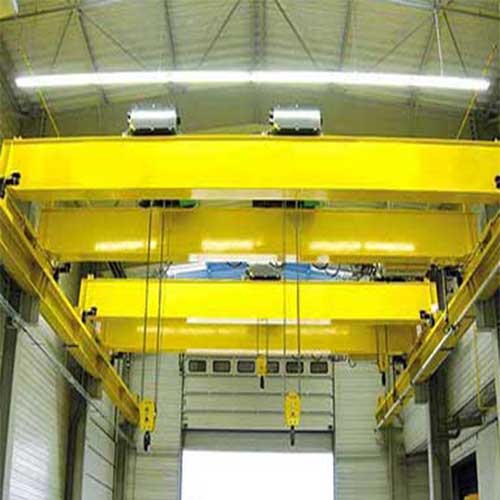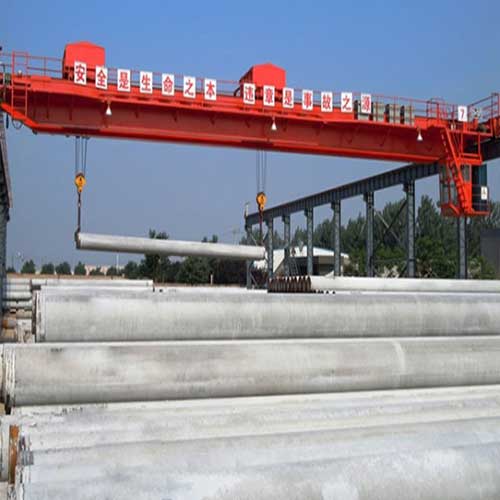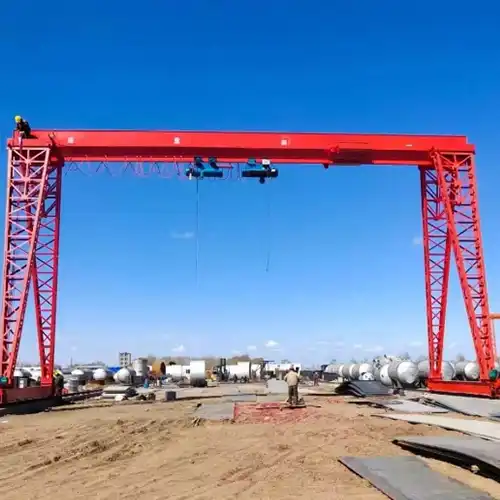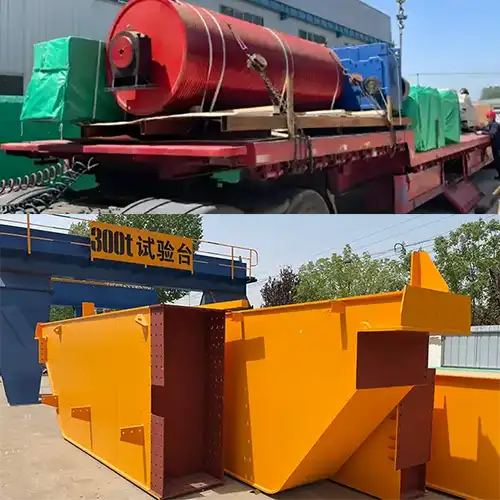Effect of Electric Hoist Synchronization on Long Material Handling
Learn how hoist synchronization accuracy impacts safety, efficiency, and material protection when handling long steel beams, slabs, and pipes.
Category: Featured
Your Trusted Overhead Crane Manufacturer & Supplier
Effect of Electric Hoist Synchronization on Long Material Handling
Overview of Long Material Handling Challenges
Moving long, heavy, or flexible materials safely requires careful planning, precise control, and reliable hoist synchronization.
Key Challenges with Long Materials
Operators face common issues when handling long materials, such as swinging, bending, or collisions with nearby structures. Even minor misalignments can cause serious damage or production delays.
- Load stability: Long or flexible materials can tilt or twist mid-lift.
- Material damage: Poor handling may lead to scratches, dents, or structural deformation.
- Operational delays: Misalignment between multiple hoists wastes time and slows production cycles.
- Safety risks: Uncontrolled swinging or sudden shifts can endanger operators and equipment.
Definition of Long Materials
Long materials are defined by their length relative to the handling system and their flexibility. Common examples include:
- Steel beams: Often 6–12 meters long and heavy; used in construction or fabrication.
- Slabs and plates: Wide and heavy; may bend under their own weight during lifting.
- Pipes and tubes: Can be long and hollow, prone to bending and swinging if not lifted evenly.
These materials require special attention because their length can magnify even small synchronization errors between hoists.
Importance of Hoist Synchronization in Overhead Cranes
For long loads, a single hoist is often insufficient. Dual or multiple hoist systems ensure that all hoists lift and move the load at the same speed and direction. Proper synchronization impacts:
- Safety: Prevents sudden swings or tilting that could harm workers or damage property.
- Precision: Keeps the load level and aligned for assembly or installation.
- Efficiency: Reduces the need for manual adjustments, saving time and labor.
How multiple hoists work together:
- One hoist may act as the master, controlling the movement of the others.
- Sensors and control systems constantly monitor load position and adjust hoist speed in real time.
- Operators can focus on guiding the load instead of correcting uneven lifting.
Fundamentals of Electric Hoist Synchronization
Electric Hoist synchronization ensures multiple hoists lift and move a load together in a coordinated way. It's essential when handling long, heavy, or flexible materials to maintain stability, safety, and efficiency during lifting operations.
Definition and Purpose
Hoist synchronization is all about making sure multiple hoists lift and move a load together in a coordinated way. It's not just a fancy feature—it's a necessity when handling long, heavy, or flexible materials. When hoists are out of sync, even by a few centimeters, the load can tilt, swing, or bend, creating safety risks and slowing down production.
In simple terms, hoist synchronization ensures that the load behaves as a single, stable unit during lifting. It keeps the material level, protects the load's integrity, and makes operators' jobs much easier.
Key points:
- Maintains load balance across all hoists.
- Prevents twisting, bending, or sudden shifts of long materials.
- Enhances safety and reduces the chance of material damage.
- Improves operational efficiency by minimizing manual corrections.
Single vs. Dual or Multi-Hoist Systems
The type of hoist system you choose depends on the load length, weight, and handling complexity.
Single hoist system:
- Suitable for shorter or rigid loads.
- Simple to operate and maintain.
- Less expensive upfront but limited in handling long or flexible materials.
Dual or multi-hoist system:
- Required for long beams, slabs, pipes, or delicate materials.
- Can lift a load at multiple points, keeping it level.
- Offers better control and reduces material stress.
- More complex and needs proper synchronization technology to work safely.
Practical takeaway: If you're dealing with materials longer than the crane span or materials that could bend easily, a dual or multi-hoist system is almost always necessary.
Mechanics and Control Methods
Synchronization can be achieved in several ways, depending on the crane design and the precision required.
Mechanical synchronization:
- Uses rigid linkages or tandem hoist setups.
- Simple, reliable, and doesn't rely on electronics.
- Best for moderate-length loads where extreme precision isn't required.
Electrical synchronization:
- Typically master-slave or PLC-controlled systems.
- Master hoist leads, and other hoists follow its movements automatically.
- Offers higher precision than purely mechanical systems.
- Can be adjusted for different load types and conditions.
Digital/servo-controlled synchronization:
- Uses sensors, encoders, and servo motors to continuously adjust hoist speeds.
- Extremely accurate for very long or flexible materials.
- Reduces operator workload and improves overall safety.
- Often used in modern, high-precision fabrication and steel plants.
Practical advice: The choice of synchronization method depends on the load characteristics, required precision, and budget. For critical applications, combining electrical or digital control with mechanical support often gives the most stable results.

double girder overhead crane with two trolleys for heavy lifting
Factors Affecting Hoist Synchronization Accuracy
Several factors determine how accurately multiple hoists move together. From the characteristics of the load to the hoist's mechanical condition and environmental influences, every detail matters in achieving safe and precise synchronization.
Load Characteristics
Not all long materials behave the same. How a load reacts during lifting depends on its weight, length, flexibility, and balance. Even small differences in the center of gravity can create uneven tension across multiple hoists, making synchronization tricky.
Key load factors:
- Weight: Heavier loads require more power, and slight motor differences can lead to uneven lifting.
- Length and flexibility: Long beams or flexible pipes can bend or sag if hoists are not perfectly coordinated.
- Center of gravity: Loads that are unevenly weighted or off-center will shift if hoists do not move in perfect harmony.
Practical tip: Always know your load's weight distribution and flexibility before choosing the number of hoists and synchronization method.
Hoist Mechanics
Even the best control system can't fully compensate for mechanical inconsistencies. The hoist itself must be well-maintained and correctly configured.
Important mechanical factors:
- Motor speed consistency: Motors on all hoists must accelerate and decelerate evenly. Small differences cause the load to tilt or sway.
- Drum design and rope tension: Uneven drum winding or incorrect rope tension can create unequal lifting speeds. Proper alignment and tension adjustment are essential.
- Wear and tear: Worn gears, bearings, or ropes affect synchronization and should be regularly checked.
Practical tip: Regular mechanical inspection and preventive maintenance are just as critical as having a high-tech control system.
Control System Parameters
The system controlling the hoists plays a major role in synchronization accuracy. Precision here determines how well hoists respond to load movement in real time.
Control system considerations:
- Sensor precision: Encoders, laser sensors, and load cells must be accurate to detect even small position differences.
- Feedback loop speed and latency: The faster and more responsive the system, the quicker it can adjust each hoist to maintain synchronization.
- Calibration: Sensors and controllers must be calibrated periodically to avoid drift over time.
Practical tip: Even small latency in the control system can create noticeable sway or tilt, especially with very long materials.
Environmental Conditions
Even the best cranes face challenges from the surrounding environment. Temperature, vibration, and structural movement can all impact synchronization.
Environmental factors:
- Temperature: Expansion or contraction of the crane structure and hoist components affects alignment.
- Vibration: Nearby machinery or vehicle movement can interfere with precise load handling.
- Bridge travel variations: Slight unevenness or misalignment in the runway beam can cause the load to shift, especially over long spans.
Practical tip: Inspect runway beams and consider environmental influences when planning lifts. A stable environment helps maintain synchronization without putting extra stress on hoists.
Impacts of Synchronization Accuracy on Handling Long Materials
The accuracy of hoist synchronization directly affects safety, efficiency, material protection, and equipment longevity. Even small deviations can have serious operational and financial consequences in workshops handling long or flexible materials.
Safety
Synchronization isn't just about efficiency—it's about keeping people and materials safe. When hoists aren't perfectly coordinated, even small differences in speed or position can make a long load tilt, swing, or twist unexpectedly.
Key safety concerns:
- Load tilting, swinging, or twisting: Uneven movement can cause the material to swing out of control, hitting nearby equipment or walls.
- Potential accidents or material damage: Operators can be at risk of injury, and valuable materials may get scratched, bent, or even dropped.
Practical tip: Always ensure hoists are synchronized and operators are trained to handle unexpected swings—especially with flexible or heavy long materials.
Operational Efficiency
Poor synchronization doesn't just create safety hazards—it slows down production. Operators often have to stop and correct misalignments, which adds time to every lift. Over the course of a day, those small delays can add up.
Efficiency impacts include:
- Time lost correcting misalignment: Frequent manual adjustments are needed when hoists aren't properly synchronized.
- Reduced throughput for repetitive lifts: Production lines can slow down when long materials cannot be moved smoothly or accurately.
Practical tip: For repetitive operations, investing in a high-precision synchronization system can save hours of labor every week.
Material Integrity
Long materials are vulnerable. Even minor tilting or uneven tension during lifting can cause permanent damage. This is particularly true for flexible steel beams, long pipes, and slabs.
Material risks include:
- Bending or deformation: Uneven lifting forces can warp beams or pipes, making them unusable for precise construction or assembly.
- Surface damage or misplacement: Scratches, dents, or misalignment during placement can lead to costly rework or scrap.
Practical tip: Always check the material's weight distribution and flexibility, and make sure your hoist system can maintain the load level throughout the lift.
Maintenance
Inaccurate synchronization doesn't just affect the load—it also takes a toll on the crane itself. Uneven stress can wear down hoist components faster than normal.
Maintenance considerations:
- Increased wear on hoists and ropes: Constant uneven tension or dragging increases strain on ropes, drums, and motors.
- Potential for uneven load on crane structure: Over time, misaligned lifts can stress beams and rails, potentially leading to long-term structural issues.
Practical tip: Schedule regular inspections and preventive maintenance. Proper synchronization reduces unnecessary wear and extends the life of both the hoists and the crane structure.
Measurement and Evaluation of Synchronization Accuracy
Key Metrics
Before you can improve hoist synchronization, you need to measure it accurately. There are several key metrics that indicate how well multiple hoists are working together.
Important metrics to monitor:
- Positional deviation between hoists: Measures how far apart the hoists are from each other while lifting. Even a few centimeters of misalignment can cause load tilting or swinging.
- Load angle deviation: Shows whether the load is staying level or tilting to one side. Essential for long or flexible materials that can bend or sag.
- Time delay in simultaneous movement: Checks if one hoist starts or stops slightly earlier than others. Small delays can magnify along the length of the load, causing uneven lifting forces.
Practical tip: Keep a log of these metrics during routine lifts to identify trends and potential mechanical or control issues before they cause problems.
Testing Methods
There are several ways to evaluate synchronization accuracy, ranging from simple field checks to advanced digital measurement systems.
Common testing methods:
- Laser measurement and motion sensors: High-precision lasers track the movement of the load in real time, highlighting even small deviations.
- Digital encoders and PLC feedback systems: These provide real-time position and speed data from each hoist, allowing operators to see misalignment and adjust accordingly.
- Field inspection and operator evaluation: Experienced operators can often detect subtle swings or uneven lifts that instruments may not fully capture. Visual checks remain a critical part of evaluation, especially for flexible or heavy materials.
Practical tip: Combine digital measurement with field inspection for the best results. Digital systems provide precise data, while human observation can catch unexpected behaviors and environmental influences.
Strategies to Improve Hoist Synchronization
Even with advanced control systems, mechanical setup plays a big role in synchronization. Small misalignments or uneven tension can throw the whole lift off balance. Below are practical strategies to enhance synchronization performance across mechanical, control, operational, and maintenance aspects.
Mechanical Adjustments
Practical mechanical strategies:
- Proper drum alignment and rope tension: Make sure all hoist drums are correctly aligned and ropes are evenly tensioned. Uneven ropes can cause one side to lift faster or slower than the other.
- Anti-sway devices: Mechanical or hydraulic anti-sway systems can reduce swinging during lifts, helping maintain stability for long materials.
Practical tip: Always check drum alignment and rope tension before starting lifts with dual or multi-hoist setups. It's a small adjustment that pays off in safer, smoother operations.
Control System Upgrades
Control systems are the brain behind hoist synchronization. Upgrading sensors and controllers can dramatically improve precision, especially for long or flexible loads.
Control improvements:
- High-precision sensors: Encoders, laser sensors, and load cells help track position and movement in real time.
- Master-slave or closed-loop control systems: These systems automatically adjust the follower hoists based on the master hoist, keeping all hoists moving in sync.
Practical tip: For plants handling long beams or flexible materials regularly, investing in a closed-loop digital system can prevent damage and save time.
Operational Best Practices
Even the best equipment won't perform well without smart operating practices. Planning and consistent procedures are essential.
Operational tips:
- Load planning and balancing: Analyze the weight distribution and plan lift points carefully. Place hoists at positions that maintain the material level and minimize stress.
- Operator training and standardized procedures: Train operators to follow consistent lifting steps and respond quickly to unexpected movements. Standardized procedures reduce the chance of errors.
Practical tip: Conduct routine training sessions and simulate challenging lifts. Experience combined with planning makes a big difference in synchronization performance.
Maintenance Considerations
Synchronization accuracy depends on well-maintained hoists and control systems. Regular inspection prevents small issues from turning into big problems.
Maintenance actions:
- Regular inspection of hoists, ropes, and motors: Look for wear, damage, or uneven performance that could affect lift consistency.
- Calibration of sensors and controllers: Sensors can drift over time, and controllers may need adjustment to maintain precise synchronization.
Practical tip: Create a preventive maintenance schedule that includes mechanical checks, control system calibration, and test lifts. Small efforts here prevent costly downtime and safety risks.
Buyer / Engineer Considerations
Understanding when and how to apply synchronized hoist systems is crucial for buyers and engineers handling long or flexible materials. The following sections outline practical decision points to help select, evaluate, and maintain the most suitable synchronization setup for your operation.
When Dual or Multi-Hoist Systems Are Necessary
Not every long material lift needs multiple hoists, but certain situations make them essential. If the load is longer than the crane span, flexible, or has uneven weight distribution, using dual or multi-hoist systems ensures the material remains level and stable throughout the lift.
Practical indicators for multiple hoists:
- Long beams, slabs, or pipes exceeding the crane hook span.
- Flexible materials that can sag or twist under their own weight.
- Loads with off-center or unevenly distributed weight.
- Frequent or repetitive lifts where efficiency and safety are priorities.
Factors to Weigh When Selecting Hoist Control Systems
Choosing the right control system can make or break long material handling efficiency. Consider the following factors carefully:
- Precision needs: Highly flexible or sensitive materials require tighter synchronization.
- Complexity of operation: Closed-loop or digital systems offer better performance but may need more training.
- Compatibility with existing cranes: Check whether your current crane mechanics and electrical systems can support advanced control systems.
- Maintenance and support: Systems that require minimal recalibration and are easy to maintain reduce long-term downtime.
Trade-Offs Between Cost, Safety, and Material Protection
High-precision synchronization systems improve safety and reduce material damage, but they come at a higher cost. Conversely, simpler systems may save money upfront but increase the risk of errors, rework, and accidents.
Practical advice:
- Evaluate the potential cost of material damage or production delays against the investment in a precise control system.
- For critical or frequent long-load lifts, prioritizing accuracy often saves money and time in the long run.
- Moderate applications with occasional long loads may work well with simpler master-slave or mechanical systems.
Checklist for Long Material Handling Solutions
Before purchasing or upgrading a hoist system, use a checklist to ensure all important factors are considered:
- Required synchronization accuracy: How precise does the load level need to be?
- Load length and weight: Are the materials long, heavy, or flexible?
- Frequency and speed of lifts: Will this be a daily operation or occasional use?
- Environmental and space constraints: Consider runway alignment, vibrations, temperature, and nearby obstacles.
Practical tip: Document each item in the checklist during planning. This ensures the crane and hoist system is tailored to your operation's actual needs rather than assumed requirements.
Conclusion
Hoist synchronization is more than just a technical feature—it’s a critical factor that directly affects safety, efficiency, and the integrity of long materials during lifting operations. When hoists are properly synchronized, loads remain level, swings and tilts are minimized, and operators can handle materials confidently and quickly. Conversely, poor synchronization can lead to safety hazards, damaged materials, operational delays, and increased maintenance costs.
Key takeaways:
- Accurate synchronization keeps long or flexible loads stable, reducing the risk of accidents.
- It improves operational efficiency by minimizing time spent correcting misaligned lifts.
- Properly synchronized lifts protect materials from bending, twisting, or surface damage.
- Maintenance and control systems play a crucial role; even small misalignments or sensor errors can affect performance.
For buyers and engineers, the best approach is to carefully assess your load types, lift frequency, environmental conditions, and required precision. Consulting with experienced crane manufacturers or suppliers is highly recommended. They can provide customized solutions tailored to your facility, helping you choose the right hoist system, control method, and maintenance plan to ensure safe, efficient, and reliable long material handling.
Practical tip: Don’t underestimate the value of a properly synchronized crane. Investing in the right system upfront saves time, reduces material losses, and keeps your team safe in the long run.
Related Products
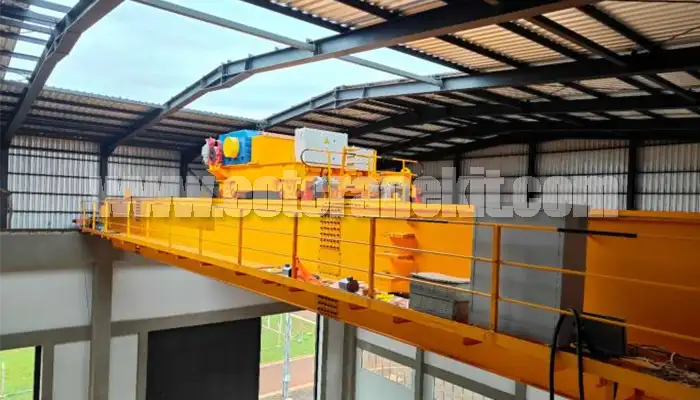
Latest project
150 Ton Overhead Crane Installation Feedback – Paraguay Case
QDX 150 ton overhead crane in action in Paraguay. Installation photos, video, and client feedback show performance, safety, and heavy-lifting efficiency.
Free consultation to Confirm Parameters & Specifications and Get
Latest Crane Price & Crane Rate.
- Types of overhead cranes : _______?
- Optional: Overhead travelling crane, goliath gantry crane,Slewing jib crane, Single girder or double girder crane,small portable crane or kbk crane, etc.
- Capacity of overhead crane: _______?
- Optional: 0.25ton, 0.5 ton, 1 ton, 2 ton, 3ton, 5 ton, 10 ton,15ton, 20ton, 25 ton, 30ton,35ton, up to 550ton, etc.
- Crane span & lifting height : _______?
- Crane travelling length : _____?
- Control of overhead crane:_______?
- Optional: pendant/ remote/cabin control
- Voltage supply of overhead crane:_____?
- Eg,: 380V50/60HZ,3Phase or others,etc.
- Application/usage of crane:_______?
- Eg,: Steel mill, ,injection mold, cement,stone, concrete,granite, general manufacturing, etc.
Just leave a message via the contact form and our hoist and crane engineer will contact you with in 24working hours.
Get In Touch
